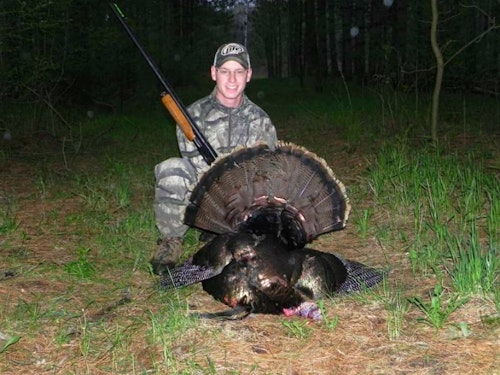
Numerous features make the over-and-under shotgun a fantastic choice for turkey hunting. Photo: Mike Schoblaska
I bought myself a new over-and-under shotgun this winter, and before I get to chase any upland birds with it, I’ll be packing it on my turkey hunts this spring. Though I didn’t specifically purchase the o/u shotgun for turkey hunting, I believe it will perform better than my pump-action shotgun. There are a number of benefits a double-barrel shotgun offers that pump-action and semi-auto shotguns simply can’t match.
The great Michael Scott from The Office once said, “I’m not superstitious, but I am a little stitious.” That rings true for me as well. And just in case there’s any bad juju related to talking down about one of your guns, I want to clear that up before getting too far ahead of myself. My pump-action shotgun is a lot like a draft horse. It does some things really well, but its size makes it less than ideal for certain activities. It’s got a 30-inch barrel with a fixed full choke, weighs in at around 7.5 pounds and measures a hair over 50 inches overall. It’s not the type of gun I want to carry for miles through the woods or plains.
By comparison, the new o/u shotgun I purchased is more like a race horse. It’s a Stevens Model 555 Deluxe. It has 28-inch barrels with interchangeable choke tubes, weighs about 6 pounds and measures only 45 inches overall. It wouldn’t be my first choice for burning through a box of 3-inch heavy goose loads from a layout blind, but that’s why I’m keeping my pump-action shotgun as well.
So, what makes the o/u shotgun a better choice as a turkey gun? The most obvious difference between the two is the number of barrels. Through my own experience and watching countless hours of turkey hunting videos, it’s no secret that sometimes birds can get in close, sometimes too close if you’re shooting shell/choke combo designed to reach out past 50 yards. The margin for error with such a tight pattern when a turkey gets up close and personal is very slim. With two barrels, I’ll be able to use a more restrictive choke tube in one barrel for further shots on wary toms that get hung up at further distances and a more open choke for birds that get right in my lap. Two barrels also provide me the opportunity to use two different types of shells if I find one patterns better with a particular choke setup. Can’t do that with a pump or semi-auto without cycling a shell, and good luck doing that with a turkey in range.

Another advantage for the o/u shotgun is the reduced weight and increased maneuverability. For those times when a turkey has you pinned and your stuck holding the gun without a rest, shaving a pound or two off the overall weight can mean the difference between a steady shot and spaghetti arms when the time comes to pull the trigger. The lighter weight will inherently impart more recoil and beat my shoulder up more with 3-inch turkey shells, but I hardly feel the recoil when I’m in the heat of the moment. The shorter length of the o/u will make it easier to move around through thick undergrowth. It might even mean the difference between hitting a sapling or weed with the muzzle while following a bird with the bead or moving past it undetected.
The last notch in the “win” category for the o/u shotgun versus a pump or semi-auto shotgun is safety and ease and control of unloading. Safety is something that gets pounded into the minds of new hunters during hunter education courses, but all too often is lacking as hunters gain more experience and confidence in their surroundings. Tell the truth, when was the last time you unloaded your shotgun or rifle before crossing a fence? Though I didn’t mention it in my response to the outdoors-related New Year’s resolution question, I am going to make an effort to be a safer hunter going forward. Unloading an o/u shotgun is as simple as plucking the shells out of the barrels if your shotgun is equipped with extractors, and if your shotgun has ejectors, you can usually catch them. This also makes leaving behind a spent shell or two a thing of the past. They’re right there in the barrel (or your hand) instead of who knows where the semi-auto shotgun launched them.
Though these features seem to make the o/u an easy choice, the double-barrel shotgun isn’t without its potential drawbacks. I’ll need to keep a close eye on point of impact versus point of aim while patterning the shotgun. Some o/u shotguns have a different POI versus POA, especially with the lower barrel. My 555 Deluxe also has a more ornate action than my pump-action shotgun, so some strategically placed camouflage tape will need to be added to cut down on the glare.
One thing to keep in mind if you’re eyeing up an older o/u shotgun in your gun safe and wondering about taking it turkey hunting this spring. Some older shotguns are not compatible with steel shot, and certain turkey loads use metals even harder than steel. Though the wad is meant to prevent contact between the payload and the barrel, check with the shotgun manufacturer if you’re unsure. Thanks to the internet, unless you have an extremely rare gun, you’re likely to find your answer with a quick Google search if you can’t reach the manufacturer.





